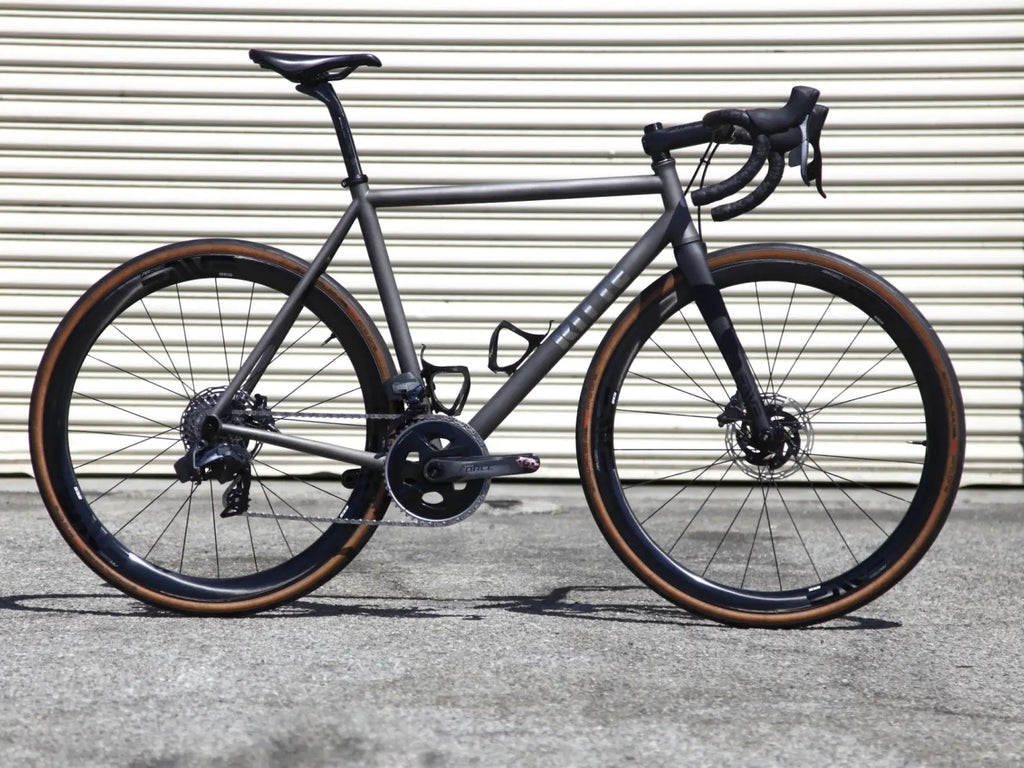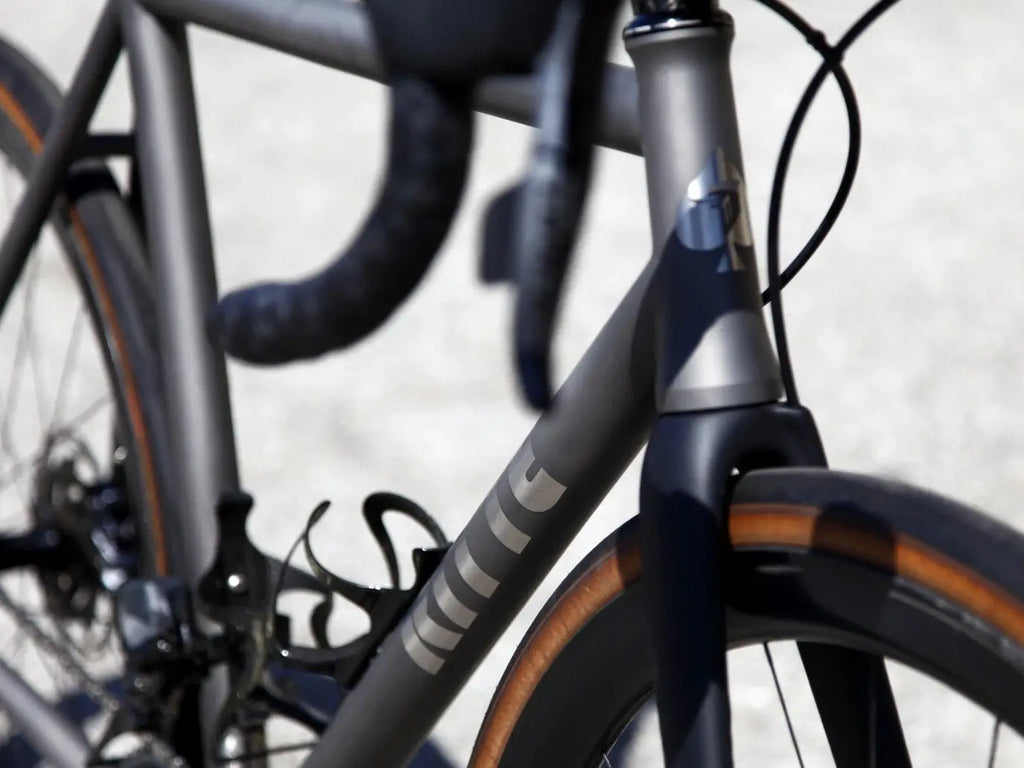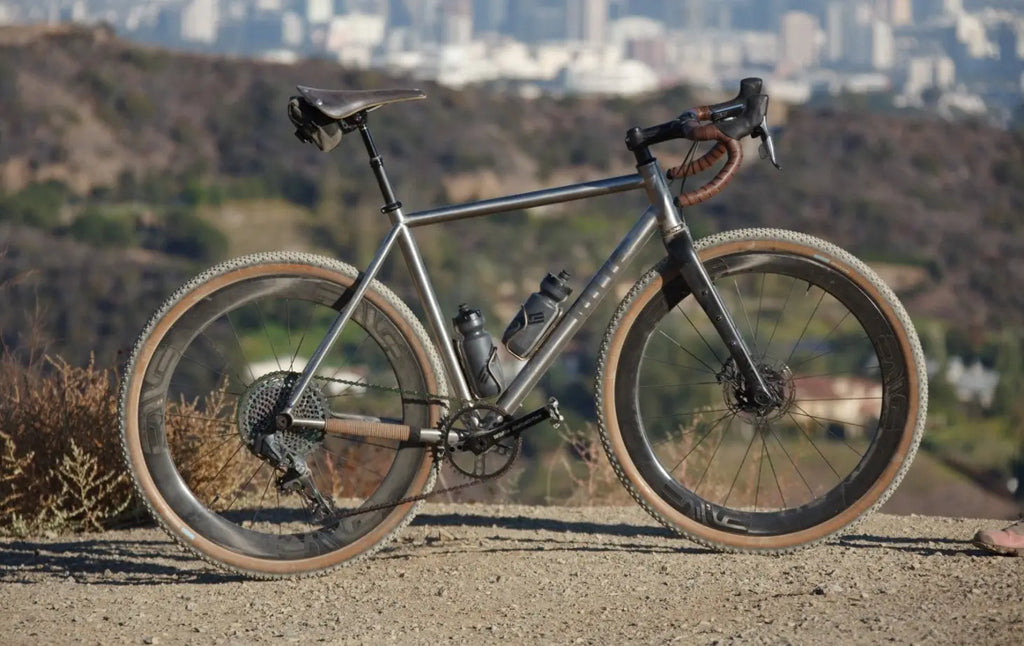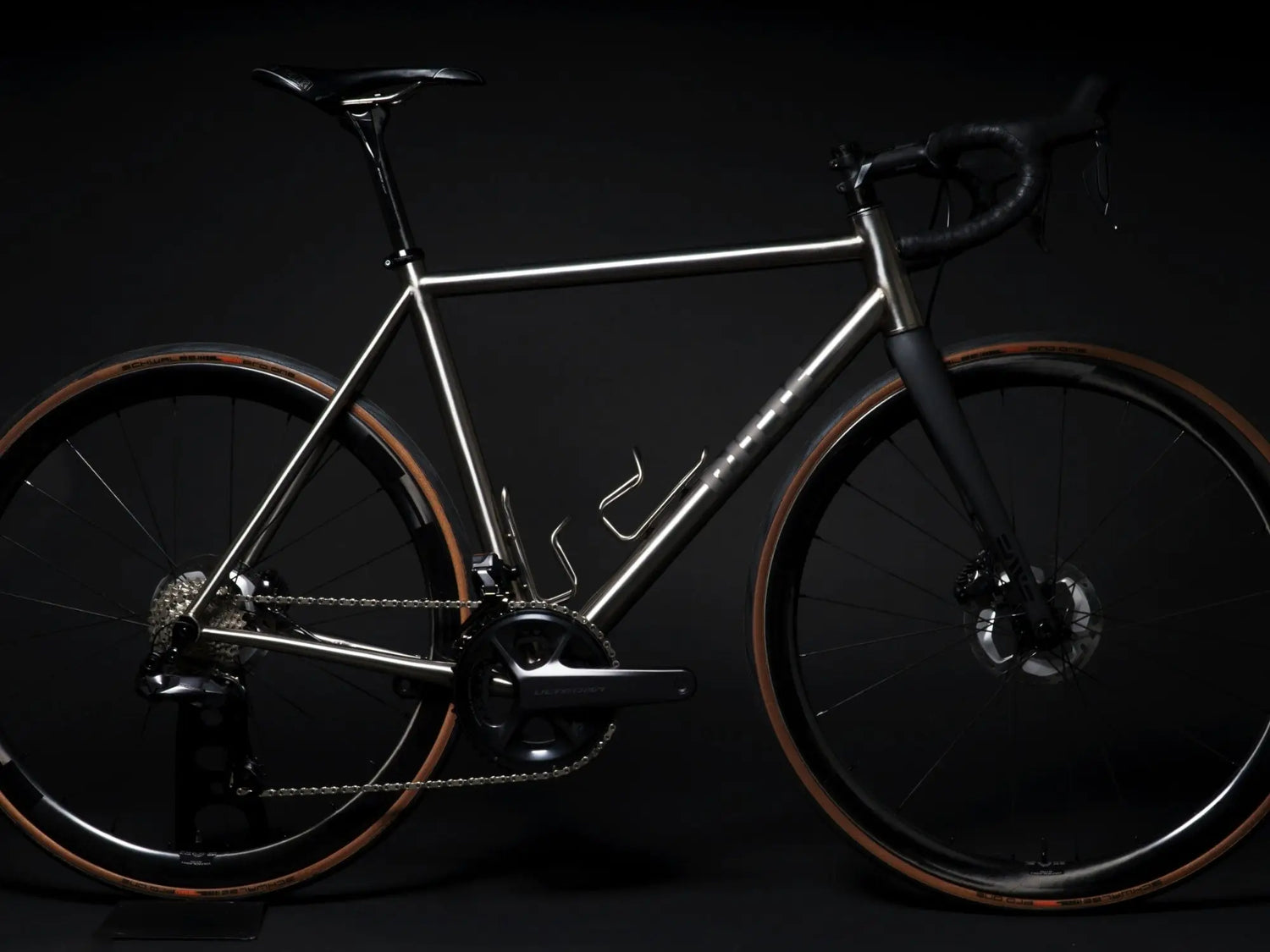Titanium bikes. You’ve seen them, you’ve drooled over them, and now you’re thinking…I need one. So which one is right for you and what makes one different from another? What makes some Ti bikes more expensive than others? Does it matter where they’re made?
When we set out to bring Ti into the Ritte line, we knew there were a lot of good options in the market - but something was always missing for us.
Ti, like steel, often gets grouped into a comfort oriented category. And for us, comfort is great but handling reigns supreme. We felt that a lot of what we had experienced was a bit too soft, a bit too relaxed. While that comfort bent is most certainly the bees knees for some, we knew we could extract the smoothness and spring of Titanium without compromising on the responsiveness and aggressiveness that Rittes have become known for.

Our relationship with Mr. Tom Kellogg and our steel bikes flowed very naturally into the development of our Titanium models. After all, Tom was one of the early pioneers of Ti road bikes. The tried and tested geometry our steel bikes have become known for translate well to any material, but when it comes to tubes it’s a whole new world. Tom had gone through decades of trial and error, material development, and custom building with Ti very specifically - so here’s how we came up with Ti bikes that blend the best of the material’s natural properties with the aggressive feel that is integral to a Ritte…
Before we divulge all the secrets, there is a bit to understand about Titanium itself. Titanium is not easy to work with - it’s a fickle material prone to warping, cold working itself, and can be difficult to shape. Ti is not as stiff as steel, not even close - this necessitates larger diameter tubes and that compounds the fickleness. In the early days of Ti bikes, builders were using tubes that were far too small in diameter to provide appropriate stiffness and torsional rigidity - you’ve undoubtedly heard the stories of early Titanium bikes being flexy.
Later on, some smart folks figured out that going up in diameter would be requisite to getting a good ride. The bigger you go in diameter, the stiffer the tube becomes - so these large diameter tubes started to get thinner walls to prevent a harsh ride or heavy frame weights. However, cycling has never been a large enough market to see significant investments from large volume titanium tubing producers. Bicycles have generally been made from aerospace, military, or industrial tubes rather than tubing specifically for bicycle applications - this means a lot of compromise.

A few producers in the US, Italy, and the UK make top quality tubing that’s specific for bicycles - swaging, butting, or otherwise manipulating the tubes to achieve the right ride qualities. And in the last few years there has been an increase of Titanium tubing on offer from elsewhere, but not all producers ensure the same consistency or tolerances. A poorly toleranced tube can be much thicker, overall, than quoted - this leads to a dead or harsh ride coupled with a heavier frame.
Even if you can get all of the “right” tubing, it’s still hard to manufacture with Ti. It’s a supremely hard material, and it work-hardens (which means that it becomes increasingly tough the harder it is worked). It’s susceptible to warping with heat, but it often demands high heat and multiple passes to weld. Simply put - it tears up tooling, cutting equipment, and requires perfectly executed fabrication with lots of heatsinks.
Titanium, for bikes, came at an inopportune time - once the kinks had been worked out, carbon and aluminum had killed off interest in production of these heavier steel and Ti alloys. It’s never been a suitable material for truly high volume production and it’s incredibly expensive (with raw material costs often exceeding 5x what a steel or aluminum bike can cost or in many cases double that of a carbon fiber bike).

So what’s the point? Why invest all the time and resources into something so difficult? The ride. It sounds crazy. All of us singing the virtues of Titanium sound like nut cases. But it’s true - Titanium is lively in a way that other materials can’t match. It’s spry, it has a spring to it. It glides over the road in a way that’s similar to steel, but at a lighter weight. It’s got an eagerness that’s closer to aluminum without the road buzz. And it’s durable - it doesn’t rust, scratches can often just be buffed out, and it shrugs off impacts that might make you think twice about composites.
So there you have it - in a world where we are often chasing fractions of a percentage improvement for the sake of marketing claims or world tour victories there stands Titanium. Equal parts absurd and wonderful, but wholly devoid of bluster. With a material like this, the benefit can be boiled down to something subjective yet easily felt: ride quality. If it wasn’t as good as all the evangelists claim it simply wouldn’t exist.
But you’ve gleaned that it’s never as simple as welding the tubes together and brushing on a beautiful finish. So we’ll give you the rundown on how we’ve approached Titanium frame building and the material itself.
With Tom fully onboard we began working out the tubing required to make our Titanium frames handle and respond the way we intended. We let the material’s natural properties speak for themselves while going to the limit of what can be done with the tubing shaping to ensure responsiveness.
Our frame philosophy and Tom’s align perfectly - we all prefer bikes that are responsive and sharp versus those that are made a bit softer. Tom’s go to tubing, that he’d used with Spectrum to achieve these characteristics without losing titanium’s wonderful ride quality, was no longer available. We pleaded our case to the tubing manufacturer and they simply said “nope, not interested in making that anymore.” So the hunt went on.

There is a pretty good range of tubing available - lots of sizes and wall thicknesses. Many frame builders have begun doing their own tube butting - using a lathe or centerless grinding to achieve an externally butted tube. But there are fewer options when it comes to internally butted or mandrel butted tubes. There are even fewer options when you start looking into swaged or tapered tubing - a tube where the diameter changes from end to end. That is what we were after.
Where an externally butted tube will change diameter (by fractions of a millimeter) in the middle, it has the same end diameters and doesn’t achieve the effect of a swaged tube. A swaged tube, because the diameter changes gradually throughout the tube’s length, is almost like cherry picking the benefits of each tube diameter. Our tubes can change diameter by as much as ~6mm, or the equivalent of two whole tube diameter steps. The larger diameter tube provides the stiffness, directness, and precision you want from a responsive race bike and the smaller diameter tube allows a hair more compliance where it matters and prevents the ride from becoming overly harsh. Swaged tubing brings the desired qualities of each of those tubes together.
Eventually, we secured the tubing we needed to build these titanium frames. When you look at a titanium Ritte, it does look a little bit different. We’re using tubes that are often much larger than the industry norm. With carefully selected wall thickness, tapers, ovalization, and bends to suit our preferences - these frames ride exactly how we wanted them to. As our titanium frames are made specific to each rider, we made sure to seek out a range of options so we can adjust the spec where needed to maintain the ride qualities for sprinters, climbers, rouleurs, or just normal cyclists.
The Satyr Ti has a front end that’s direct and precise in feel. It doesn’t get knocked off it’s line even in rough conditions and there is no torsional slop in the steering. The rear end clears big tires and pedals efficiently, but has a little bit of compliance built into it with shaped, oval chainstays. This touch of extra compliance means that not only does it not beat you up over a long day, but it climbs smoothly over uneven ground due to a tiny bit more deflection than a road bike - allowing the rear wheel to track well with less bounce.
The Snob, well, it had to be as hardcore quick as our original Snobs were. We brought the moniker back for our new, Made in USA titanium road frame and it needed to live up to the hype (and more). This bike has the same goals in terms of front end precision but the acceleration is turned up to 11. We’ve extended our use of swaged tubing down to the chaninstays to give the bike a feel of instant acceleration and excellent torsional rigidity without losing the spring that makes a titanium bike so lovely. It jumps with you when you begin a spring out of the saddle and it carves into corners in a way that must be felt to be appreciated.
We’re very excited about these bikes - if you haven’t ridden titanium, we think you’ll be a convert. If you’re a titanium devotee, well, you may not be switching religions but we think you’ll join our church.
Drop us a line, let's chat bikes and see if one of these titanium Rittes is right for you.




